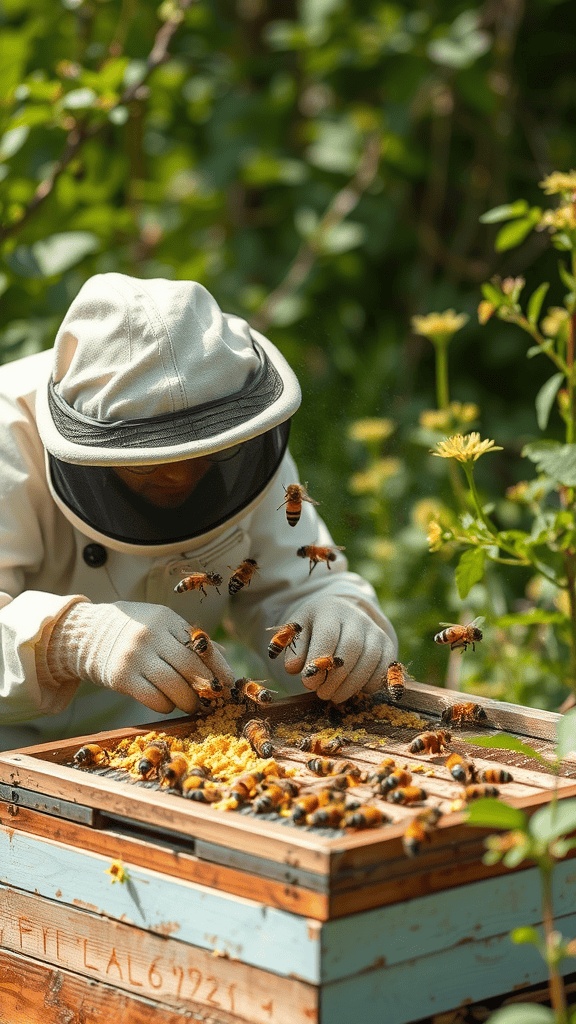The Role of Oxalic Acid in Beekeeping: Benefits and Application Techniques
Oxalic acid is gaining traction in the world of beekeeping due to its effectiveness in managing certain challenges that beekeepers face. Its primary role is in controlling varroa mites, a common pest that threatens bee colonies. Understanding how oxalic acid works, its benefits, and the various application techniques can be crucial for both novice and experienced beekeepers.
The varroa mite (Varroa destructor) can devastate honeybee populations if not managed properly. This external parasite attaches itself to the bees, feeding on their blood and weakening them. In time, this mite infestation can lead to the collapse of an entire colony. Oxalic acid, as a naturally occurring organic compound, provides a safe and effective means of addressing this issue.
One of the principal benefits of using oxalic acid in beekeeping is its ability to kill varroa mites without significant harm to the bees. When applied correctly, it targets the mites while minimizing stress on the bee colony. Additionally, oxalic acid is a widely available compound, making it accessible to beekeepers everywhere.
Benefits of Using Oxalic Acid
- Effective Mite Control: Research shows that oxalic acid can reduce varroa mite populations significantly, which helps in maintaining healthy hives.
- Natural Option: Being a naturally occurring substance, it is often preferred by beekeepers looking for organic treatment options.
- Ease of Access: Oxalic acid is relatively easy to obtain and can be purchased from suppliers that focus on beekeeping supplies.
- Flexible Application: It can be applied in various ways, depending on beekeeper preferences and hive conditions.
- Low Residue: This compound leaves minimal residue, ensuring that honey and beeswax produced remain safe for consumers.
Despite these advantages, it’s vital to understand the product’s application techniques to maximize its efficacy and ensure the safety of your bee colony. Oxalic acid can be applied in several different ways, each with its own specifics and best practices.
Application Techniques
Here are a few common methods for applying oxalic acid in your hive:
- Sublimation: This method involves heating oxalic acid to turn it into vapor. The vapor fills the hive, allowing it to come into contact with the mites directly. This technique requires specialized equipment like a vaporizer to ensure safety and effectiveness.
- Liquid Treatment: Diluting oxalic acid in a sugar syrup solution and spraying it onto bees can also be effective. It’s important to ensure that you cover the bees thoroughly for better results.
- Drip Method: With this method, a solution of oxalic acid and sugar syrup is dripped directly onto the bees. This technique is typically used in the fall when populations of bees are lower, and there are fewer brood cells where mites may hide.
Regardless of the method you choose, timing and temperature play a crucial role in the success of oxalic acid treatments. It is most effective during periods when bees are not rearing brood since varroa mites can hide inside brood cells, rendering treatments less effective. It’s advisable to treat your hives when nighttime temperatures are above 50°F (10°C), as this is when bees cluster tightly, and the treatment can be more effectively administered.
Moreover, caution should always be exercised when handling oxalic acid. It is considered hazardous and can be harmful if ingested or if it comes into contact with skin. Always wear protective gear such as gloves and goggles when using this compound to protect yourself while ensuring your bees remain healthy.
Oxalic acid is a powerful tool for beekeepers seeking to control varroa mites. By understanding its benefits and mastering the application techniques, you can bolster hive health and productivity. Continuous learning and attention to detail will not only aid in successful treatment strategies but also ensure that you maintain thriving bee colonies for years to come.
Understanding Varroa Mite Control: How Oxalic Acid Plays a Critical Role
Beekeeping is a rewarding endeavor, but it comes with many challenges, particularly in managing pests like the Varroa mite. This tiny, parasitic creature can cause significant harm to honeybee colonies if not controlled effectively. Understanding how various control methods work is essential for any beekeeper. One method that has gained attention is the use of oxalic acid. In this article, we will explore the critical role that oxalic acid plays in controlling Varroa mites and how you can implement it in your beekeeping practices.
What Is Oxalic Acid?
Oxalic acid is a naturally occurring compound found in various plants, including rhubarb and spinach. In beekeeping, it is primarily used as a treatment against Varroa mites due to its effectiveness and relatively low toxicity to bees when applied correctly. It works by disrupting the mite’s ability to reproduce, which helps decrease their population within the hive.
How Does Oxalic Acid Work Against Varroa Mites?
When oxalic acid is applied to the bees or to the brood area, it penetrates the exoskeleton of the Varroa mite upon contact. Once inside, it affects the mite’s internal systems, leading to dehydration and eventual death. This method is particularly useful during periods when there is little to no brood present, as Varroa mites primarily reproduce in sealed brood cells. Targeting the mites in this way can significantly reduce their numbers.
Methods of Application
There are generally two main methods for applying oxalic acid:
- Trickle Method: This technique involves mixing oxalic acid with a sugar solution and directly applying it to the bees in the hive. It is crucial to ensure that the mixture is properly dosed to avoid harming your bees.
- Vaporization Method: In this method, oxalic acid is heated to produce a vapor that fills the hive. This approach is often preferred because it allows for even distribution and reduces the risk of overstimulation.
When to Use Oxalic Acid
Timing is vital when using oxalic acid for mite control. The best periods to apply oxalic acid include:
- Early fall, right before winter when the population of adult bees is high and there is little or no brood.
- Late winter, when the colony begins to wake up but before the queen starts laying eggs.
Using oxalic acid at these times ensures optimal effectiveness since mites reproduce primarily in the presence of brood.
Safety Considerations
While oxalic acid can be a highly effective tool in mite management, it is essential to handle it with care. Here are some safety tips:
- Always wear gloves, goggles, and a mask when handling oxalic acid to prevent skin contact or inhalation.
- Ensure proper ventilation when using the vaporization method, as the fumes can be harmful if inhaled in large quantities.
- Store any unused oxalic acid in a secure area away from children and pets.
Integrating Oxalic Acid into Your Beekeeping Routine
To efficiently manage Varroa mites, you should incorporate oxalic acid into a broader Integrated Pest Management (IPM) strategy. Here are some steps to consider:
- Regularly monitor your colonies with Varroa mite tests to determine the infestation level.
- Use oxalic acid treatments strategically alongside other mite control methods, such as screen bottom boards and drone comb removal.
- Educate yourself and stay updated on best practices and new research regarding mite control.
By taking a proactive approach to Varroa mite management and incorporating oxalic acid into your beekeeping practices, you can maintain healthier colonies and ensure a thriving apiary. Remember, successful beekeeping relies on understanding both your bees and the challenges they face, including pests like the Varroa mite.
Oxalic acid plays a critical role in beekeeping, particularly in managing Varroa mites. By learning about its use, the timing of treatment, and safety considerations, you can better protect your colonies and contribute to the sustainability of bees in agriculture.
Conclusion
As you delve into the world of beekeeping, understanding the role of oxalic acid becomes essential for both the health of your hive and the productivity of your bees. The benefits of oxalic acid are clear, particularly in its effectiveness against the notorious Varroa mite. By employing various application techniques, beekeepers can ensure that their colonies remain strong and disease-free.
The fight against Varroa mites is a significant challenge faced by beekeepers today. These pests can decimate entire colonies if left unchecked. By using oxalic acid in a strategic manner—whether through dribbling or vaporization—you can significantly reduce mite populations without compromising the health of your bees.
It’s vital to stay informed and practice proper dosages as you work with oxalic acid, ensuring you incorporate it into an integrated pest management plan. Remember, the well-being of your bees directly relates to their ability to pollinate effectively and produce honey. Through targeted treatments and ongoing education, you can foster a thriving environment for your bees.
Oxalic acid serves not just as a remedy, but as a cornerstone in the quest for sustainable beekeeping. Embracing its use will result in healthier hives and a more robust bee population, ultimately leading to greater yields and a more balanced ecosystem. By prioritizing this knowledge, you’re taking a crucial step towards maintaining happy and productive bee colonies.
As an Amazon Associate, I earn from qualifying purchases.

